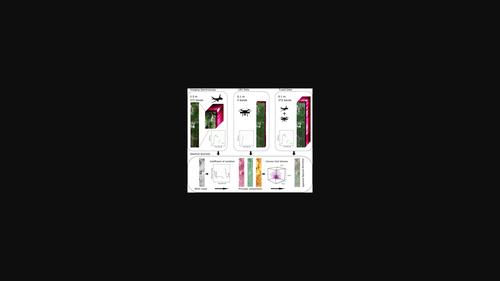当前位置:
X-MOL 学术
›
Remote Sens. Ecol. Conserv.
›
论文详情
Our official English website, www.x-mol.net, welcomes your feedback! (Note: you will need to create a separate account there.)
Spatial resolution, spectral metrics and biomass are key aspects in estimating plant species richness from spectral diversity in species-rich grasslands
Remote Sensing in Ecology and Conservation ( IF 5.5 ) Pub Date : 2021-11-12 , DOI: 10.1002/rse2.244 Christian Rossi 1, 2, 3 , Mathias Kneubühler 1 , Martin Schütz 2 , Michael E. Schaepman 1 , Rudolf M. Haller 3 , Anita C. Risch 2
Remote Sensing in Ecology and Conservation ( IF 5.5 ) Pub Date : 2021-11-12 , DOI: 10.1002/rse2.244 Christian Rossi 1, 2, 3 , Mathias Kneubühler 1 , Martin Schütz 2 , Michael E. Schaepman 1 , Rudolf M. Haller 3 , Anita C. Risch 2
Affiliation

|
Increasing evidence suggests that remotely sensed spectral diversity is linked to plant species richness. However, a conflicting spectral diversity–biodiversity relationship in grasslands has been found in previous studies. In particular, it remains unclear how well the spectral diversity–biodiversity relationship holds in naturally assembled species-rich grasslands. To address the linkage between spectral diversity and plant species richness in a species-rich alpine grassland ecosystem, we investigated (i) the trade-off between spectral and spatial resolution in remote sensing data; (ii) the suitability of three different spectral metrics to describe spectral diversity (coefficient of variation, convex hull volume and spectral species richness) and (iii) the importance of confounding effects of live plant biomass, dead plant biomass and plant life forms on the spectral diversity–biodiversity relationship. We addressed these questions using remote sensing data collected with consumer-grade cameras with four spectral bands and 10 cm spatial resolution on an unmanned aerial vehicle (UAV), airborne imaging spectrometer data (AVIRIS-NG) with 372 bands and 2.5 m spatial resolution, and a fused data product of both datasets. Our findings suggest that a fused dataset can cope with the requirement of both high spatial- and spectral resolution to remotely measure biodiversity. However, in contrast to several previous studies, we found a negative correlation between plant species richness and spectral metrics based on the spectral information content (i.e. spectral complexity). The spectral diversity calculated based on the spectral complexity was sensitive to live and dead plant biomass. Overall, our results suggest that remote sensing of plant species diversity requires a high spatial resolution, the use of classification-based spectral metrics, such as spectral species richness, and awareness of confounding factors (e.g. plant biomass), which may be ecosystem specific.
中文翻译:

空间分辨率、光谱指标和生物量是从物种丰富草原的光谱多样性估计植物物种丰富度的关键方面
越来越多的证据表明,遥感光谱多样性与植物物种丰富度有关。然而,在先前的研究中发现了草原中相互矛盾的光谱多样性-生物多样性关系。特别是,目前尚不清楚光谱多样性 - 生物多样性关系在自然组装的物种丰富的草原中的表现如何。为了解决物种丰富的高山草原生态系统中光谱多样性与植物物种丰富度之间的联系,我们研究了(i)遥感数据中光谱和空间分辨率之间的权衡;(ii) 三种不同光谱指标对描述光谱多样性(变异系数、凸包体积和光谱物种丰富度)的适用性和 (iii) 活植物生物量的混杂效应的重要性,死亡植物生物量和植物生命形式对光谱多样性-生物多样性的关系。我们使用无人机 (UAV) 上使用具有四个光谱波段和 10 cm 空间分辨率的消费级相机收集的遥感数据、具有 372 个波段和 2.5 m 空间分辨率的机载成像光谱仪数据 (AVIRIS-NG) 来解决这些问题,以及两个数据集的融合数据产品。我们的研究结果表明,融合数据集可以满足高空间和光谱分辨率的要求,以远程测量生物多样性。然而,与之前的几项研究相比,我们发现植物物种丰富度与基于光谱信息内容(即光谱复杂性)的光谱指标之间存在负相关。基于光谱复杂性计算的光谱多样性对活植物和死植物生物量敏感。总体而言,我们的研究结果表明,植物物种多样性的遥感需要高空间分辨率,使用基于分类的光谱指标,如光谱物种丰富度,以及对可能是生态系统特定的混杂因素(如植物生物量)的认识。
更新日期:2021-11-12
中文翻译:

空间分辨率、光谱指标和生物量是从物种丰富草原的光谱多样性估计植物物种丰富度的关键方面
越来越多的证据表明,遥感光谱多样性与植物物种丰富度有关。然而,在先前的研究中发现了草原中相互矛盾的光谱多样性-生物多样性关系。特别是,目前尚不清楚光谱多样性 - 生物多样性关系在自然组装的物种丰富的草原中的表现如何。为了解决物种丰富的高山草原生态系统中光谱多样性与植物物种丰富度之间的联系,我们研究了(i)遥感数据中光谱和空间分辨率之间的权衡;(ii) 三种不同光谱指标对描述光谱多样性(变异系数、凸包体积和光谱物种丰富度)的适用性和 (iii) 活植物生物量的混杂效应的重要性,死亡植物生物量和植物生命形式对光谱多样性-生物多样性的关系。我们使用无人机 (UAV) 上使用具有四个光谱波段和 10 cm 空间分辨率的消费级相机收集的遥感数据、具有 372 个波段和 2.5 m 空间分辨率的机载成像光谱仪数据 (AVIRIS-NG) 来解决这些问题,以及两个数据集的融合数据产品。我们的研究结果表明,融合数据集可以满足高空间和光谱分辨率的要求,以远程测量生物多样性。然而,与之前的几项研究相比,我们发现植物物种丰富度与基于光谱信息内容(即光谱复杂性)的光谱指标之间存在负相关。基于光谱复杂性计算的光谱多样性对活植物和死植物生物量敏感。总体而言,我们的研究结果表明,植物物种多样性的遥感需要高空间分辨率,使用基于分类的光谱指标,如光谱物种丰富度,以及对可能是生态系统特定的混杂因素(如植物生物量)的认识。


























 京公网安备 11010802027423号
京公网安备 11010802027423号